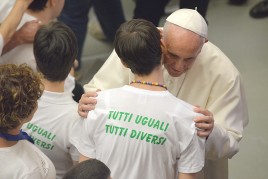
“Along a thousand roads” is the name of the vade mecum compiled by the National Youth Ministry Service (SNPG), headed by Fr Michele Falabretti. Its purpose is to optimize the organization of the pilgrimage of Italian youths due to convene in Rome August 11 to 12 2018, the year of the Synod, to meet Pope Francis. Dioceses, regions and youths groups are starting to take action and after the first meetings emerged the first questions: must the pilgrimage be diocesan or regional? How large should the group be? What is the length of the journey? How can we turn it into an experience to integrate disabled persons and foreigners? What about those not taking part in the pilgrimage?
Diocesan or Regional? The answer is clear. For SNPG
“the local diocese should be the point of reference of the experience.
We would like for this pilgrimage – in some ways guided and supported by the bishop – to include the presence of youths from parishes, belonging to associations and movements, as well as groups animated by men and women religious.” A second possible dimension, is written in the publication, “is inter-diocesan. It would be useful if smaller dioceses came together to organize their itinerary. In this respect the metropolitan diocese is an important point of reference, and in many Italian regions it is a benchmark in the sharing of numerous pastoral activities. Smaller ecclesial regions are taking action in unison at regional level: this is useful only in the case of small numbers and involves a dozen dioceses.” Youth organizations present at national level are suggested to organize their own itineraries.
How large should the group be? In this case SNPG suggests two criteria: the first relates to “the organizational capacities of the group that undertakes the journey.” The second criteria is that
“Nobody must be excluded from participating”
for this reason “the organization should be flexible, envisaging the possibility of extending the number of participants or reconsidering the dimension of the group in the final stages.” A useful piece of advice is “to seek the guidance of diocesan pilgrimage offices and/or of other ecclesial bodies involved in the pastoral care of the pilgrimage.”
What should be the length of the journey? “We measure it in terms of time and not of space”, is the indication of the vade mecum. Moreover, “the number of kilometres walked is not as important as the amount of time spent together.” An experience that lasts a few days will enable to partake in “Eucharistic celebrations and prayers, to proceed along the journey in silence and dialogue, to share meetings bearing Christian witness, stopovers marked by service or civil commitment, visiting significant sites (shrines, places for the care of the person, cloister monasteries, prisons or places of marginalization…) or with historical and artistic bearing.” The chosen itinerary should seek “to include the experiences of faith that are present along historical pilgrimage itineraries nationwide.”
An experience of integration: disabled persons and foreigners. “The significance of the experience we propose – SNPG made known – lies in the opportunity of exercising integration.” This applies to
People with disabilities: they should not be left “home.”
In fact they should be kept near, “for mutual caring enables everyone’s growth.” There ensues the need to “reassess personal timeframes” also in view of a shared, collective caring effort, so that the journey may not be burdensome for some and effortless for others.”
 Foreign youths deserve the same degree of attention. “Many of them are Catholics, and in many cases they are not involved or taken into consideration.” So it’s important to operate in conjunction with the diocesan coordinators of Migrantes and/or Caritas in one’s own diocese, especially in places having structured communities with a significant number of young people.” It is equally important to include “those youths who are distant from our traditional environments, probably baptized Catholics who for various reasons have grown distant from the life of the Church.”
Foreign youths deserve the same degree of attention. “Many of them are Catholics, and in many cases they are not involved or taken into consideration.” So it’s important to operate in conjunction with the diocesan coordinators of Migrantes and/or Caritas in one’s own diocese, especially in places having structured communities with a significant number of young people.” It is equally important to include “those youths who are distant from our traditional environments, probably baptized Catholics who for various reasons have grown distant from the life of the Church.”
What about those not taking part in the pilgrimage? To all of these youths, the vade mecum proposes to participate in the meeting of Italian youths with the Pope scheduled for August 11-12. In this respect, states SNPG, “we will try to extend the registration deadline as much as possible. We are working on an electronic registration system that will be detailed during the “Itineraries presentation” in the Italian town of Sacrofano (January 26/27 2018). Registration is “necessary and mandatory” also for security reasons. In fact, “access to meeting areas will be patrolled by law enforcement agents.”












